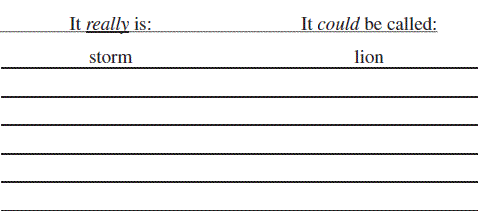 The aim of this activity is to learn the poetry writing techniques of metaphor and simile.
The aim of this activity is to learn the poetry writing techniques of metaphor and simile.
Poetry is like porridge: it warms the body and the soul. Metaphors and similes can be a strong part of poetry. Kids love using metaphor and simile, often doing so even if they are not familiar with the terms. The concept of metaphor is something they frequently already use unconsciously. Even very young writers, unfamiliar with the definitions, will understand the idea.
Explain to your students that when we compare two things and say they are “like” each other it is called a simile. (“The rain fell like tears.”) In a metaphor, dissimilar things are compared without the word “like.” (“The moon was a beckoning lantern.”)
Metaphor
The dragon in the poem is the ocean, but it’s never directly stated:
breathing foam
on rocky, green toes.
It roars,
then softly rumbles,
retreats to attack again.
It gathers misty breath
and strength
to roar back with all its might and eat away at sand and caves,
its belly softly rumbling.
It rests.
Gray back panting, heaving,
rise and fall, it slumbers
then wakes again and roars,
spitting foam and salty mist.
When you write a metaphor, you use your imagination to describe it. I compared the ocean to a dragon. You could call a storm “a fierce lion” or a flower “a yellow symphony.” Brainstorm with your students what other comparisons you could make. Make a list of similes and metaphors on the blackboard. For example:
– My kitten is like a powder puff
– Homework is like eating spinach
– Sunshine is like honey
– Icy teeth hung off the roof
Make a list of real things and then write a metaphor for that word:

Now invite your students to pick one metaphor and write a metaphor poem!
Here’s one of my favorites. Sarah compared “the wind” to “angels” in her poem:
wailing high and low.
They sweep between the maple trees,
as on and on they blow.
The angels’ gray and foggy skirts
are dragging through the grass.
And as I look out my window,
By and by they pass.
(Sarah, Grade 7)
Flying Free
I know that if I really try,
deep down I know that I can fl y!
Standing on a fence,
flapping with my hands,
I’ll soar through the sky,
like a bird I will fly.
Floating free as a cloud
over treetops I’ll sail about,
I know that if I really try,
deep down I know
that I can fly!
So, here I go!
(Margriet Ruurs)
“Like a bird I will fly,” the poem says.
What other expressions do we use to compare ourselves to animals?
Can your students think of some? Write all suggestions down on the blackboard.
Did they think of “quiet as a mouse”? “Gentle as a lamb”? We say, “You swim like a fi sh” and “He is strong as bear.” Save the list of animal similes you now have for use in future poems.
Invite your students to write down other common similes. Now ask them to choose one simile and write a poem about it. They might choose to write a poem about being strong as a horse, roaring like a lion, or swimming like a fish!
“Guess What?”
It is fun to turn metaphor poetry into a game by writing poems and asking each other to guess what it really is about. Ask your students to think of a subject and then decide what it is like. This is similar to how I decided that the ocean is like a dragon. If your students need warming up to this activity, discuss more examples, list them on the board, and allow your students to use those. Here are some suggestions:
– Spring could be “a butterfl y.”
– Rain could be “tears.”
– Worries can be “a heavy package” or “a suitcase.”
One of my students wrote about a rainbow, calling it a smile in the sky:
an upside-down smile in the sky.
After the tears go
the upside-down smile starts to glow.
(Chelsey, Grade 4)
To demonstrate the guessing element, read this poem to your students without revealing the title. Ask them to guess what it is about.
Now ask your students to write their poems but when sharing, not to reveal the true subject. Turn the sharing of the poems into a guessing game by inviting the rest of the class to guess the real topic of each poem!

